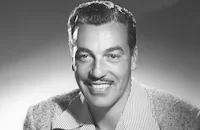Lost Continent
Brief Synopsis
Cast & Crew
Samuel Newfield
Cesar Romero
Hillary Brooke
Chick Chandler
John Hoyt
Acquanetta
Film Details
Technical Specs

Synopsis
After being launched from a United States military proving grounds in White Sands, New Mexico, an atomic powered test rocket goes off target and falls to earth out of range of government radars. Needing to recover the rocket quickly before national security is breached, Air Force Maj. Joe Nolan, his WW II co-pilot Lt. Daniel Wilson and airplane mechanic Sgt. William "Willie" Tatlow are assigned to transport distinguished Russian scientist Dr. Michael Rostov, Geiger counter expert Robert Phillips and American scientist Stanley Briggs to a remote part of the earth where it is believed the rocket landed. To ensure the secrecy of their mission, the group is ordered not to make radio contact until they find the rocket and retrieve its data. After flying for several hours they near the point at which radio contact was lost with the rocket and Phillips notices the Geiger counter jumping wildly. Joe and Wilson suddenly lose control of the plane when the electrical systems fail and are forced to crash-land on the nearest island. Everyone survives, but the Geiger counter continues to register intense radioactivity. Soon after entering the jungle they meet a native girl, who, having learned English from missionaries, tells them of a huge bird of fire that landed on the mountain top, warning them that the sacred mountain has always been taboo. The group begin climbing the mountain's steep rocky cliffs, but Briggs is weak and has a difficult time keeping up with the men and Rostov is forced to stay by his side to help him. Suddenly, as they round a bend, a poisonous gas caused by volcanic activity chokes them and they decide to camp in a cave for the night. During the evening Briggs, the only family man among them, quietly regrets coming on the mission and Rostov spots a huge reptilian monster illuminated by a bolt of lightning. The next day, as they continue their perilous journey, Briggs loses his balance and reaches for Rostov, but loses his grip and falls to his death. Joe, suspicious of Rostov's Russian background, implies that Rostov deliberately killed Briggs and later intimates to Wilson that Rostov might be a Russian spy. Soon after, they reach the top of the mountain and find a strange prehistoric jungle with steaming pools, "a lost continent" covered in a strange green haze. After Phillip's readings show the area is covered in unrefined uranium, the most dangerous and precious of metals, the group follows Phillips as the readings grow even hotter. Along the way, Wilson recognizes fresh tracks belonging to a huge beast. Soon after, they spot a full-size brontosaurus, who attacks them, wounding Phillips, while the others fire numerous rounds, finally forcing the creature to leave. The next morning the group wakes to discover Phillips and Rostov have disappeared. They frantically search for them and find Rostov, who leads them to Phillips, trapped under a rock and delirious with pain. The men quickly free Phillips and he explains that, his interest piqued by the dinosaurs, he woke early to take pictures of them. He then graciously thanks Rostov for helping the others find him after which Joe apologizes to Rostov for his previous suspiciousness. Rostov accepts the apology and explains that he is often accused of being a spy, but he lost his respect for Russia while being detained in concentration camps during World War II. Later that day, with no sign of the rocket, only one round of ammunition left and little food, the group's morale is low, but they shoot a flying pterodactyl for food, and as they look for the kill they spot the rocket, surrounded by dinosaurs. While the others divert the beasts's attention, Phillips and Rostov retrieve the data recordings from the ship, which will help them perfect the next rocket. Suddenly from behind a rock, a dinosaur attacks and kills Willie. The four remaining men are forced to make their escape, but the mountain begins to crumble as earthquakes shake and split the earth. As they rush the remaining way down, they can hear the last cries of the dinosaurs. They make it to water's edge and paddle a village boat to safety as they watch the explosive disintegration of the island. Rostov sagely concludes, "A world is coming to an end. Better this way than have it living with us."

Director
Samuel Newfield
Cast

Cesar Romero

Hillary Brooke
Chick Chandler

John Hoyt

Acquanetta

Sid Melton

Whit Bissell
Hugh Beaumont
Murray Alper
William Green
Crew
Alfred Berke
Phil Cahn
Diane
Paul Dunlap
George C. Emick
Jack Greenhalgh
John Hall
Orville Hampton
Richard Landau
Fred Lau
Jack Leewood
Robert L. Lippert
Robert L. Lippert
Augie Lohman
Ray Mercer
Sigmund Neufeld
Dave Newell
Stanley Newfield
Harry Ross
Bert Sternbach
F. Paul Sylos
Carroll Young

Film Details
Technical Specs

Quotes
Look at the size of that footprint! I've never seen anything like it before!- Nolan
I have. Once... in a museum.- Phillips
Trivia
Some sequences were originally tinted green on the original release prints.
Notes
Although Jack Leewood is listed onscreen only as "associate," film reviews list him as the associate producer. Although the viewed print was black and white, several of the film's reviews and a April 19, 1951 Hollywood Reporter news item state that the background scenes for pre-historic sequences were tinted green. A January 3, 1951 Hollywood Reporter news item states that Murray Lerner was producing the film and negotiating with Veronica Lake to co-star. According to a April 24, 1951 Los Angeles Daily News news item, the dinosaur animation sequences, which total less than ten minutes in the film, took five months and 800 feet of film to shoot. In addition to established stop motion techniques to animate the dinosaur sequences, motors were used to make the animation less shaky. A April 26, 1951 Hollywood Reporter news item adds Peter Damon, Richard Foote, Ed Hinton, Clark Howat, Will Orlean, John Pell and House Peters to the cast, but their appearance final in the final film has not been confirmed.












